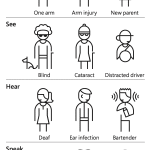In a recent webinar I learned how sensitivity editors review fiction books. I found myself wondering: as part of inclusive UX, how might we incorporate cultural sensitivity editing?
Inclusivity is a broad term. It means making sure that a device or content or system works for everyone. Specifically, people who are often excluded or marginalized. For example, accessibility is an important part of inclusivity because people with disabilities are otherwise overlooked. That means an accessibility expert will review an app or website to make sure it works for people with disabilities. In the same way, a cultural sensitivity editor reviews content with an eye for bias or problematic language.
What is a Sensitivity Editor?
A sensitivity editor is a person, typically from a marginalized community, who reads a book to check that the depiction of all characters is culturally appropriate. They look for bias, cultural inaccuracies, representation issues, and stereotypes.
These are often issues in nonfiction work as well. Think about how important inclusivity is in UX. Our microcopy, our long-form content, our healthcare explanations and app help text. In other words, everything you write! You need to review it all for bias, assumptions and stereotypes.
How to Use a Sensitivity Editor in UX Writing
Here are a few things a sensitivity editor could review in your UX writing.
- Behavioral personas: In fiction, a sensitivity editor reviews characters. They make sure the characters aren’t two-dimensional, and aren’t based on stereotypes. In UX personas are our “characters” and we are subject to the same issues. We need to make sure they are behavioral, rather than merely demographic, and that we don’t rely on stereotypes.
- Cultural inaccuracies: You would think this would be obvious, but anything referencing a culture should be accurate. For example, when a website offers gifts for “bar mitzvahs” instead of “bar and bat mitzvahs” (or better yet, “b’nai mitzvot”) I notice. It’s part of my culture, and while I appreciate the effort to include Judaism, it’s insulting to see the error. Use copywriters who have lived experience as a member of any culture included in your audience.
- Bias: It’s so hard to identify bias in your own work. That’s why a good sensitivity editor can help. Remember, there are a lot of types of bias, and having bias doesn’t make you a bad person! Ignoring your bias, on the other hand… that’s dangerous.
- Problematic language: Language is evolving. But many people in positions of privilege don’t recognize when a word or phrase is problematic. A sensitivity editor can spot problematic language before it gets to – and harms – your audience.
Normalize Sensitivity Editing
We are in a time of change. And it’s amazing how many opportunities there are to improve our work. For example, many companies are looking for ways to become more inclusive.
Hiring a sensitivity editor is one concrete way to improve life


